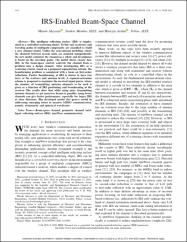| dc.contributor.author | Alayasra, Musab | |
| dc.contributor.author | Arslan, Hüseyin | |
| dc.date.accessioned | 2022-06-23T12:43:18Z | |
| dc.date.available | 2022-06-23T12:43:18Z | |
| dc.date.issued | 2022 | en_US |
| dc.identifier.citation | Alayasra, M. ve Arslan, H. (2022). IRS-enabled beam-space channel. IEEE Transactions on Wireless Communications, 21(6), 3822-3835. http://doi.org/10.1109/TWC.2021.3124288 | en_US |
| dc.identifier.issn | 1536-1276 | |
| dc.identifier.issn | 1558-2248 | |
| dc.identifier.uri | http://doi.org/10.1109/TWC.2021.3124288 | |
| dc.identifier.uri | https://hdl.handle.net/20.500.12511/9532 | |
| dc.description.abstract | The intelligent reflecting surface (IRS) is emphasized as a controlled scattering cluster. To this end, scatterers and traveling paths of multipath components are classified to build a new channel model. Unlike the conventional modeling, where the channels between system units are modeled independently, the new model considers the channel as a whole and decomposes it based on the traveling paths. The model shows clearly how IRS, in the beam-space context, converts the channel from a problem into a design element. After investigating IRS as a scattering cluster, based on a proposed segmentation scheme, the beamforming problem is considered with a focus on first-order reflections. Passive beamforming at IRS is shown to have two tiers; at the scatterer and antenna levels. A segment-activation scheme is proposed to maximize the received signal power, where the number of transmitting antenna elements to be used is given as a function of IRS positioning and beamforming at the receiver. The results show that while using more transmitting antenna elements to get narrower beams is possible, using fewer elements can give better performance, especially for larger IRS at close distances. The developed model also proves useful in addressing emerging issues in massive MIMO communication, namely, stationarity and spherical wavefronts. | en_US |
| dc.language.iso | eng | en_US |
| dc.publisher | IEEE-Institute of Electrical and Electronics Engineers Inc. | en_US |
| dc.rights | info:eu-repo/semantics/openAccess | en_US |
| dc.subject | Beam-Space Channel | en_US |
| dc.subject | Geometric Channel | en_US |
| dc.subject | Intelligent Reflecting Surface (IRS) | en_US |
| dc.subject | mmWave Communication | en_US |
| dc.title | IRS-enabled beam-space channel | en_US |
| dc.type | article | en_US |
| dc.relation.ispartof | IEEE Transactions on Wireless Communications | en_US |
| dc.department | İstanbul Medipol Üniversitesi, Mühendislik ve Doğa Bilimleri Fakültesi, Elektrik ve Elektronik Mühendisliği Bölümü | en_US |
| dc.authorid | 0000-0001-8362-3972 | en_US |
| dc.authorid | 0000-0001-9474-7372 | en_US |
| dc.identifier.volume | 21 | en_US |
| dc.identifier.issue | 6 | en_US |
| dc.identifier.startpage | 3822 | en_US |
| dc.identifier.endpage | 3835 | en_US |
| dc.relation.tubitak | info:eu-repo/grantAgreement/TUBITAK/SOBAG/120C142 | |
| dc.relation.publicationcategory | Makale - Uluslararası Hakemli Dergi - Kurum Öğretim Elemanı | en_US |
| dc.identifier.doi | 10.1109/TWC.2021.3124288 | en_US |
| dc.institutionauthor | Alayasra, Musab | |
| dc.institutionauthor | Arslan, Hüseyin | |
| dc.identifier.wosquality | Q1 | en_US |
| dc.identifier.wos | 000809406400022 | en_US |
| dc.identifier.scopus | 2-s2.0-85128172590 | en_US |
| dc.identifier.scopusquality | Q1 | en_US |


















